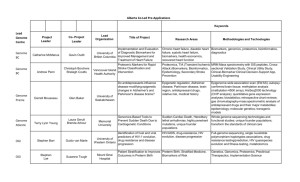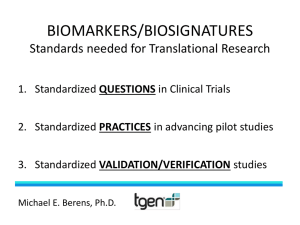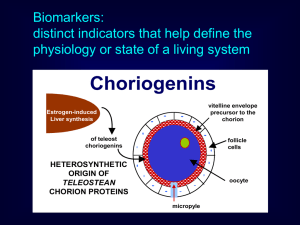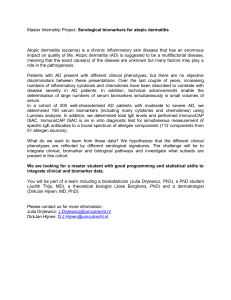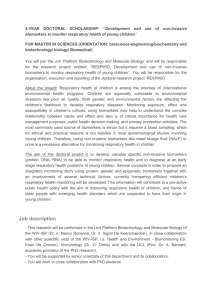Integrating Biomarkers in Population–based Research Syllabus
advertisement
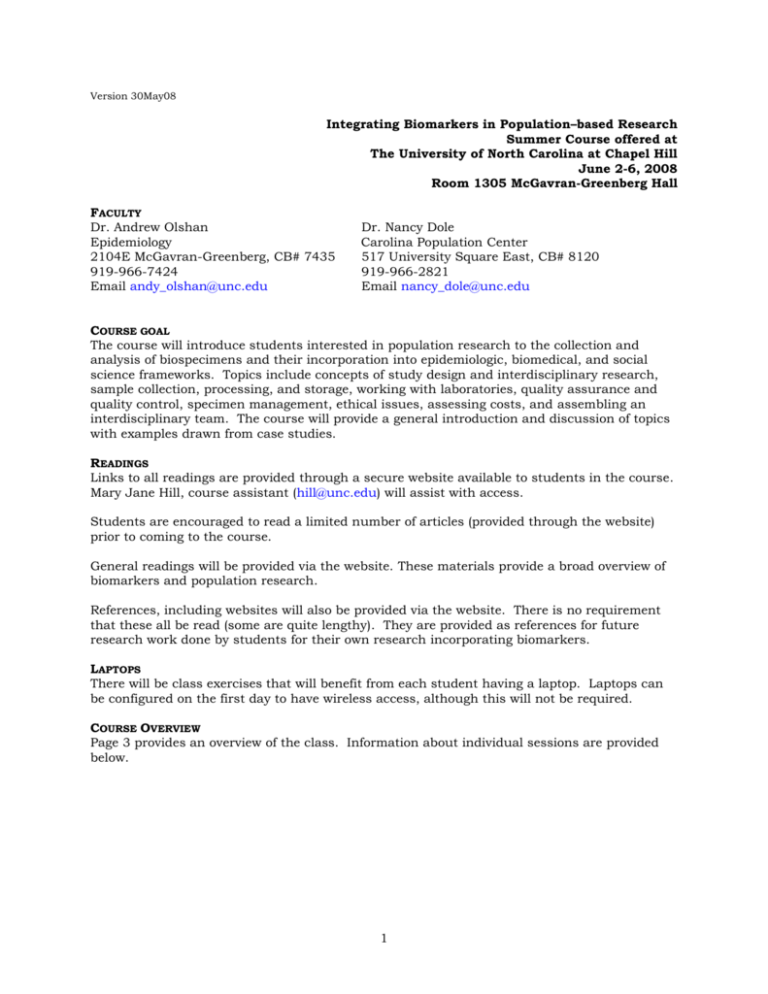
Version 30May08
Integrating Biomarkers in Population–based Research
Summer Course offered at
The University of North Carolina at Chapel Hill
June 2-6, 2008
Room 1305 McGavran-Greenberg Hall
FACULTY
Dr. Andrew Olshan
Epidemiology
2104E McGavran-Greenberg, CB# 7435
919-966-7424
Email andy_olshan@unc.edu
Dr. Nancy Dole
Carolina Population Center
517 University Square East, CB# 8120
919-966-2821
Email nancy_dole@unc.edu
COURSE GOAL
The course will introduce students interested in population research to the collection and
analysis of biospecimens and their incorporation into epidemiologic, biomedical, and social
science frameworks. Topics include concepts of study design and interdisciplinary research,
sample collection, processing, and storage, working with laboratories, quality assurance and
quality control, specimen management, ethical issues, assessing costs, and assembling an
interdisciplinary team. The course will provide a general introduction and discussion of topics
with examples drawn from case studies.
READINGS
Links to all readings are provided through a secure website available to students in the course.
Mary Jane Hill, course assistant (hill@unc.edu) will assist with access.
Students are encouraged to read a limited number of articles (provided through the website)
prior to coming to the course.
General readings will be provided via the website. These materials provide a broad overview of
biomarkers and population research.
References, including websites will also be provided via the website. There is no requirement
that these all be read (some are quite lengthy). They are provided as references for future
research work done by students for their own research incorporating biomarkers.
LAPTOPS
There will be class exercises that will benefit from each student having a laptop. Laptops can
be configured on the first day to have wireless access, although this will not be required.
COURSE OVERVIEW
Page 3 provides an overview of the class. Information about individual sessions are provided
below.
1
BROAD COURSE OBJECTIVES
Hypothesis Objective
Student should be able to:
(1) enumerate the advantages and disadvantages of choosing various biomarkers for specific
hypotheses
(2) list specific challenges in collecting biomarkers
(3) illustrate investigator decisions that go into the decision about study design when
biomarkers are involved
Ethical Objective
Student should be able to:
(1) recognize ethical concerns that arise from the collection of biomarkers that are different
from other forms of data.
(2) write sections of a consent form involving collection of biomarkers
Barriers Objective
Student should be able to:
(1) evaluate the costs and benefits for decisions about inclusion of common biomarkers
Study Design Objectives: Population–based designs and clinic–based study designs
Student should be able to:
(1) describe the unique components of a population–based design and a clinic–based design
(2) describe the strengths and weaknesses of each design
(3) differentiate the sampling strategies and their role in feasibility, cost, quality of measures,
inference, and generalizablity from these designs
Integrating Objective
Student should be able to:
(1) give examples of biomarkers appropriate for a specific study
(2) articulate the benefits and challenges associated with these choices
Specimen Management Objectives
Student should be able to:
(1) identify key elements required for developing detailed protocols for specimen collection and
management
(2) operationalize field activities for a specific biomarker.
Selecting a Lab Objectives
Student should be able to:
(1) enumerate important elements of choosing a lab and the collaboration requirements.
Quality Assurance/Quality Control Objective
Student should be able to:
(1) review and assess a QA/QC plan provided by a lab
Advanced Lab Techniques & Emerging Approaches Objective
Student should be able to:
(1) enumerate new biomarker techniques that are available or underway
(2) identify the strengths and weaknesses of using these techniques in a population–
based study vs. a controlled environment
2
Biomarker summer course schedule, June 2-6, 2008, 1304 & 1305 McGavran-Greenberg Hall
Monday, 6/2/08
9:00-10:15
Concepts
Introduction
--course logistics & reference
materials
--big-picture models
--general concepts
--biomarker examples
--intro to course sessions
(Olshan)
Tuesday, 6/3/08
Wednesday, 6/4/08
Thursday, 6/5/08
Friday, 6/6/08
Population-based vs.
clinic-based designs
(Barbara Entwisle)
Selection of biomarkers to
address hypotheses
-- broad scope
-- examples of biomarkers
-- intro to DNA
(Olshan)
Biomarker collection in
international settings
(Steve Meshnick)
Advanced lab techniques &
emerging approaches
(David DeMarini)
Specimen management &
selecting a lab
(Dole & Olshan)
QA/QC
working with a lab
(Jeannette Bensen)
Human subjects
--exercise of opt-in or opt-out
of genetic components
--local institution IRB forms
or UNC's biospecimen
consent form
(Dole, Olshan)
Politics of using biomarkers
-- advisory boards to review
use of banked specimens
How to build a collaborative
team
(Kathie Harris, John Thorp,
Olshan, Dole)
[wireless setup]
10:30-12:00
Specifics &
exercises
Overview of studies with
biomarkers:
--Add Health
--National Children's Study
(Dole)
{wireless setup]
1:30-5:00
Applied
Add Health & NCS biomarker
review and collection
specifics with collection kit
--exercise reviewing draft
and final saliva collection
protocols
--kit to collect saliva that
night and next morning
(Dole, Carmen Cuthbertson)
[course evaluation]
SPLIT CLASS BETWEEN THE FOLLOWING 2 SESSIONS:
DNA collection
--intro to collecting & processing DNA
--Biospecimen Processing facility lab visit
(Tricia Basta, Olshan)
------------------------------------------------------------------------------Review saliva collection experience
Tracking systems
--bar codes
--organizing specimens from tubes to freezers
Visit CPC freezer room (blood spot processing)
(1:30-2:00 Carolyn Halpern; Jodie Lee, Janne Groner, Dole)
3
Estimating costs of collecting
biomarkers
-- exercise of selecting
biomarkers to collect and
developing a draft budget
and justification
(students work on their own
laptop)
(Dole)
JUNE 2
Concepts Session [9:00-10:15]
Introduction to the Course
Presenters: Dr. Andy Olshan, Dr. Nancy Dole, Ms. Mary Jane Hill
SESSION content includes
course logistics and references
review how the course website working group is organized
general concepts and integration across disciplines
biomarker examples
introduction to course sessions
Specifics & Exercises Session [10:30-12:00]
Overview of Case Studies Collecting Biomarkers
Presenters: Dr. Nancy Dole
Introduction to two case studies of population-based research that includes collection of
biomarkers – the National Longitudinal Study of Adolescent Health (Add Health) and the
National Children’s Study (NCS).
Add Health website: http://www.cpc.unc.edu/addhealth
National Children’s Study (NCS) national website: http://www.nationalchildrensstudy.gov/
North Carolina Study Center for the NCS website: http://www.cpc.unc.edu/ncs
Applied Session [1:30-5:00]
Add Health and National Children’s Study – Specifics about Collecting Biomarkers
Presenters: Dr. Nancy Dole, Ms. Carmen Cuthbertson
SESSION content includes
review of the specific biomarkers and what they will measure in each study
plans for archiving specimens for future use
example of the field supplies used for Add Health
exercise reviewing a draft and final saliva collection kit used in a pregnancy cohort
study
exercise collecting saliva
4
JUNE 3
Concepts Session [9:00-10:15]
Broad Concepts in Study Design: Population–based designs and clinic–based study
designs
Presenters: Dr. Barbara Entwisle
Featured case study: National Children's Study
SESSION content includes
distinction between source of the population and the population at risk
how numerators and denominators of the candidate and actual study population
are determined
how specific aims involving biomarkers are formulated to match the study's
hypotheses
descriptions from interdisciplinary research that has integrated biomarkers
Specifics & Exercises Session [10:30-12:00]
Specimen Management & Selecting a Lab
Presenters: Dr. Nancy Dole, Dr. Andy Olshan
SESSION content includes
collection protocols and supplies
processing the specimens
explain storage and shipping requirements and options (aliquots, thaw/refreeze
cycles, returned samples)
automated tracking systems
freezer maintenance, alarms, call lists
integration of staff; importance of multiple staff involved
research labs vs. commercial labs
challenges of speaking a different language
getting written protocols from the lab
identifying lab collaborators
environmental health & shipping safety
Applied Session [1:30-5:00]
CLASS WILL BE SPLIT INTO TWO GROUPS – SESSIONS WILL BE REPEATED ON JUNE 4
Group 1: DNA collection
Presenters: Dr. Tricia Basta, Dr. Andy Olshan
SESSION content includes
Biospecimen Processing (BSP) facility lab visit
intro to collecting & processing DNA
collect a mouth rinse for DNA assessment
see a lab in action running the specimens
lab person walks through steps from collection to assay and storage
5
Group 2: Tracking Systems, Blood Spot Processing, & Freezer Room Organization
Presenters: Dr. Nancy Dole, Dr. Carolyn Halpern, Ms. Jodi Lee, Ms. Janne Groner
SESSION content includes
review saliva collection experience, pilot experiences from the Add Health Study
discuss tracking systems
bar codes
organizing specimens from tubes to freezers
visit CPC freezer room
observe processing of Add Health blood spots coming in from the field
6
JUNE 4
Concepts Session [9:00-10:15]
Selection of Biomarkers to Address Study Hypotheses
Presenter: Dr. Andy Olshan
SESSION content includes
broad scope
examples of biomarkers
what specimens to collect to address specific hypotheses
what should be measured, why, and when?
can it be collected in the population of interest?
is a goal of the study to bank specimens? if so, why?
integration of scientific goals and lab capabilities early in the research project
process
examples of studies that have incorporated biomarkers and why
introduction to DNA
Specifics & Exercises Session [10:30-12:00]
Quality Assurance/Quality Control (QA/QC)
Presenter: Dr. Jeannette Bensen
SESSION content includes
making sure QA/QC measures are in place in the lab processing specimens and/or
doing assays
how to identify and deal with lab errors
repeat assessments across batches and/or across labs
what data does the lab report to the study?
what's important in different disciplines (laboratory, epidemiology, social science)
REFERENCE
EPA website on QA/QC: http://www.epa.gov/quality/qatools.html
Applied Session [1:30-5:00]
REPEAT OF JUNE 3 APPLIED SESSION
Group 1: Tracking Systems, Blood Spot Processing, & Freezer Room Organization
Presenters: Dr. Nancy Dole, Dr. Carolyn Halpern, Ms. Jodi Lee, Ms. Janne Groner
Group 2: DNA collection
Presenters: Dr. Tricia Basta, Dr. Andy Olshan
7
JUNE 5
Concepts Session [9:00-10:15]
Biomarker Collection in International Settings
Presenters: Dr. Steve Meshnick
SESSION content includes
political & legal issues
limited in-country resources – staffing, supplies
ethical issues
special requirements for collection and shipping
special barriers
Specifics & Exercises Session [10:30-12:00]
Human Subjects Issues
Presenters: Dr. Nancy Dole, Dr. Andy Olshan
SESSION content includes
description of what is being collected for consent
what results should be reported to study participants or the community
provision of treatment or counseling
long–term storage and use as consent protocols change
establishing policies to make biomarkers available to other researchers (storage,
consent, sharing)
specific discussion of confidentiality
changing respondent behavior or health status (especially if results are reported and
design is longitudinal –– not unique to biomarkers)
Exercises include:
opt-in or opt-out of genetic components
completing their own IRB requirements or UNC's biospecimen consent form
Exercise requires laptop needed.
Applied Session [1:30-5:00]
Estimating Costs of Collecting Biomarkers
Presenter: Dr. Nancy Dole
SESSION content includes
cost to collect, process, store, assay
logistics (cold chain, adequately trained staff for all components in desired setting)
Exercise of students selecting biomarkers they want to collect and developing a draft budget
and justification (students need their own laptop for this exercise)
8
JUNE 6
Concepts Session [9:00-10:15]
Advanced Lab Techniques & Emerging Approaches
Presenter: David DeMarini
SESSION content includes
what is coming and caveats
assessment, e.g., proteomics, metabolomics
emerging genomic studies
Specifics & Exercises Session [10:30-11:30]
Politics and Logistics of Incorporating Biomarkers into Population Research –
panel discussion
Presenters: Dr. Kathie Harris, Dr. John Thorp, Dr. Andy Olshan, Dr. Nancy Dole)
SESSION content includes
advisory boards to review use of banked specimens
how to build a collaborative team
banking “local” samples in a multi-site study
respondent burden and effect on response rate
Course Evaluation [11:30-12:00]
Presenter: Dr. Nancy Dole
Course ends at Noon
9
GENERAL READINGS & REFERENCES
The following are readings and references that may be of use in your future work with
biomarkers:
Banalata S, Mahadevan B, DeMarini DM. 2007. Transcriptional responses to complex
mixtures–A review. Mutation Research 636(1-3): 144-77.
Bergen AW, Haque KA, Qi Y, Beerman MB, Garcia–Closas M, Rothman N, Chanock SJ. 2005.
Comparison of yield and genotyping performance of multiple displacement amplification
and OmniPlex™ whole genome amplified DNA generated from multiple DNA sources.
Human Mutation 26: 262–70.
Beskow, LM, Botkin, JR, Daly, M, Juengst ET, Soleymani LL, Merz JF, Pentz R, Press NA, Ross
LF, Sugarman J, Susswein LR, Terry SF, Austin MA, Burke W. 2004. Ethical issues in
identifying and recruiting participants for familial genetic research. American Journal of
Medical Genetics. Part A 130(4): 424–431.
Butz WP, Torrey BB. 2006. Some frontiers in social science. Science 312:1898–900.
Chung CH, Levy S, Chaurand P, Carbone DP. 2007. Genomics and proteomics: Emerging
technologies in clinical cancer research. Critical Reviews in Oncology/Hematology. 61(1):
1-25.
Claudino WM, Quattrone A, Biganzoli L, Pestrin M, Bertini I, Di Leo A. 2007. Metabolomics:
Available results, current research projects in breast cancer, and future applications.
Journal of Clinical Oncology 25(19): 2840-6.
Eiseman E, Bloom G, Brower J, Clancy N, Olmsted SS. 2003. Case studies of existing human
tissue repositories: “Best Practices” for a biospecimen resource for the genomic and
proteomic era. Santa Monica: RAND Corporation. 243 p.
García-Closas M, Egan KM, Abruzzo J, Newcomb PA, Titus-Ernstoff L, Franklin T, Bender PK,
Beck JC, Le Marchand L, Lum A, Alavanja M, Hayes RB, Rutter J, Buetow K, Brinton LA,
Rothman N. 2001. Collection of genomic DNA from adults in epidemiological studies by
buccal cytobrush and mouthwash. Cancer Epidemiology, Biomarkers & Prevention 10(6):
687-96.
Garcia–Closas M, Moore LE, Rabkin CS, Franklin T, Streuwing J, Ginzinger D, Alguacil J,
Rothman N. 2006. Quantitation of DNA in buccal cell samples collected in epidemiological
studies. Biomarkers 11: 472–9.
Glass TA, McAtee MJ. 2006. Behavioral science at the crossroads in public health: Extending
horizons, envisioning the future. Social Science & Medicine 62:1650–71.
Goodman GE, Thornquist MD, Edelstein C, Omenn GS. 2006. Biorepositories: let's not lose
what we have so carefully gathered! Cancer Epidemiology, Biomarkers & Prevention. 15(4):
599-601.
Harville EW, Savitz DA, Dole N, Herring AH, Thorp JM, Light KC. Patterns of salivary cortisol
secretion in pregnancy and implications for assessment protocols. Biol Psychol. 2007
Jan;74(1):85-91. Epub 2006 Sep 18.
Hede K. 2006. New biorepository guidelines raise concerns. Journal of the National Cancer
Institute. 98(14): 952-4.
10
Hobcraft J. 2006. The ABC of demographic behaviour: How the interplays of alleles, brains,
and contexts over the life course should shape research aimed at understanding
population processes. Population Studies 60:153–87.
Holland NT, Smith MT, Eskenazi B, Bastaki M. 2003. Biological sample collection and
processing for molecular epidemiological studies. Mutation Research 543: 217–34.
Holland NT, Pfleger L, Berger E, Ho A, Bastaki M. 2005. Molecular epidemiology biomarkers –
sample collection and processing considerations. Toxicology and Applied Pharmacology
06: 261–8.
International Society for Biological and Environmental Repositories (ISBER). 2005. Best
Practices for repositories I: collection, storage, and retrieval of human biological materials
for research. Cell Preservation Technology 3: 5–48.
Knudsen EI, Heckman JJ, Cameron JL, Shonkoff JP. 2006. Economic, neurobiological, and
behavior perspectives on building America’s future workforce. PNAS: Proceedings of the
National Academy of Sciences of the United States of America. 103(27):10155-62.
McDade TW, Williams S, Snodgrass JJ. 2007. What a drop can do: Dried blood spots as a
minimally invasive method for integrating biomarkers into population-based research.
Demography 44:899-925.
Michael RT, O’Murcheartaigh CA. 2008. Design priorities and disciplinary perspectives: The
case of the US National Children’s Study. Journal of the Royal Statistical Society: Series A
(Statistics in Society) 171(2): 465–80.
Muñoz A, Gange SJ. 1998. Methodological issues for biomarkers and intermediate outcomes in
cohort studies. Epidemiologic Reviews 20: 29–42.
National Bioethics Advisory Commission. August 1999. Research involving human biological
materials: Ethical issues and policy guidance, Volume I. Rockville MD: National Bioethics
Advisory Commission. 138 p.
National Cancer Institute. 2007. Best practices for biospecimen resources. 48p.
National Health and Nutrition Examination Survey (NHANES). Laboratory Procedures Used for
the Third National Health and Nutrition Examination Survey (NHANES III, 1988-94).
1996. Hyattsville, MD: NCHS. 754 p.
Ness RB, Samet JM, Camargo CA, Hiatt RA; ACE Policy Committee. 2007. American College of
Epidemiology weighs in on new NCI biorepository guidelines. Annals of Epidemiology 7(1):
81-2.
Pierce JD, Fakhari M, Works KV, Pierce JT, Clancy RL. 2007. Understanding proteomics.
Nursing & Health Sciences 9(1): 54-60.
Ransohoff DF. 2005. Bias as a threat to the validity of cancer molecular-marker research.
Nature Reviews. Cancer 5(2): 142-9.
Schulte PA, Perera F. Molecular epidemiology: principles and practice. San Diego : Academic
Press, 1993. 588 p. (UNC Health Sciences Library, QH 506 M7187 1993)
11
Steinberg K, Beck J, Nickerson D, Garcia–Closas M, Gallagher M, Caggana M, Reid Y,
Cosentino M, Ji J, Johnson D, Hayes RB, Earley M, Lorey F, Hannon H, Khoury MJ,
Sampson E. 2002. DNA banking for epidemiologic studies: A review of current practices.
Epidemiology 13: 246–54.
Tworoger SS, Hankinson SE. 2006. Collection, processing, and storage of biological samples in
epidemiologic studies: sex hormones, carotenoids, inflammatory markers, and proteomics
as examples. Cancer Epidemiology, Biomarkers & Prevention 15: 1578–81.
Valeggia CR. 2007. Taking the lab to the field: Monitoring reproductive hormones in
population research. Population & Development Review 33(3): 525-42.
Vaught JB. 2006. Blood collection, shipment, processing, and storage. Cancer Epidemiology,
Biomarkers & Prevention 15: 1582–584.
Webb PM, Merritt MA, Boyle GM, Green AC. 2007. Microarrays and epidemiology: not the
beginning of the end but the end of the beginning... Cancer Epidemiology, Biomarkers &
Prevention 16(4): 637-8.
Weinstein, M, Willis RJ. 2000. Stretching social surveys to include bioindicators: possibilities
for the Health and Retirement Survey, experience from the Taiwan Study of the Elderly. In:
National Research Council. Cells and surveys: should biological measures be included in
social science research? Committee on Population. Finch CE, Vaupel JW, and Kinsella K,
eds. Commission on Behavioral and Social Sciences and Education. Washington DC:
National Academy Press. p 250–75.
Weisberg HF. 2005. The total survey error approach. Chicago: University of Chicago Press. p 5–
28, 225–57. (Chapters 1, 2 and 10)
Wilcox AJ. 1995. Molecular epidemiology: Collision of two cultures. Epidemiology 6: 561–2.
RELATED MATERIALS AND WEBSITES
BioSpecimen Processing (BSP) Facility
The UNC BSP Facility provides laboratory support for investigator-initiated large-scale clinical,
epidemiologic, and other studies and functions as a human biospecimen repository. It also
serves as a resource for clinicians who wish to store and study samples from unusual or
potentially important patients.
CPC Biomedical website
The Biomedical Services core aids Carolina Population Center projects in incorporating
biomedical specimen collection and assays into their research.
Manual of Pathology and Laboratory Medicine Clinical Services
A guide to the use of the Clinical Laboratory and Anatomic Pathology Services available at the
University of North Carolina Hospitals. Includes the McLendon Clinical Laboratories Safety
Manual.
International Society for Biological and Environmental Repositories (ISBER) provides
information on logistics and storage of specimens
National Cancer Institute Office of Biorepositories and Biospecimen Research
12
UNC-CH’s Office of Environment, Health, and Safety has information on safely handling
biological specimens, and requirements for shipping biological specimens:
Laboratory Safety Manual
Biological Safety Manual
Saf-T-Pak is one of several companies that sell packaging materials for shipping biological
samples. Under “Links” their website provides links to many of the regulatory requirements for
such shipments. (http://www.saftpak.com/)
Ethics and Human Subject Links
Office of Human Research Ethics (OHRE), UNC-CH
A Guide to the IRB Process
The Institutional Review Board (IRB) is a committee established to review and
approve research involving human subjects. The primary purpose of the IRB is to
protect the rights and welfare of the human subjects.
IRB Guidance for Student Research and Class Projects
The National Institutes of Health Bioethics Resources on the Web provides a number of
annotated web links
13
